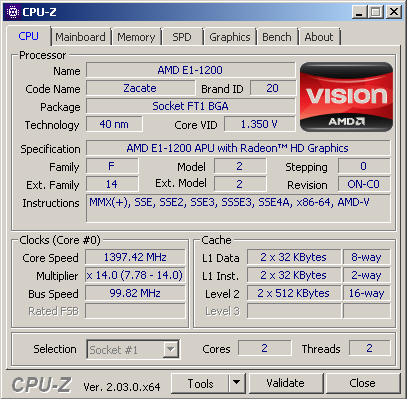Comparing: AMD A6-3400M vs AMD E1-1200
In this comparison, we analyze two Processors: AMD A6-3400M and AMD E1-1200, using synthetic benchmark tests to evaluate their overall performance. This side-by-side comparison helps users understand which hardware delivers better value, speed, and efficiency based on standardized testing. Whether you're building a new system or upgrading an existing one, this benchmark-driven evaluation offers valuable insights to guide your decision.
Specification Comparison Table
This specification comparison presents technical details of several devices or components to help you understand the key differences between each option. Use this table as a reference to determine which device best suits your needs.
| Specification | AMD A6-3400M | AMD E1-1200 |
|---|---|---|
| Architecture | x86 | x86 |
| Technology | 32 nm | 40 nm |
| Clock | 1.4 GHz - 2.3 GHz | 1.4 GHz - - |
| Core/Thread | 4 / 4 | 2 / 2 |
| Segmen | Mobile | Mobile |
Submission Comparison Table
This submission comparison table displays the number and details of benchmark data submissions from various devices or components. This information helps you understand the performance based on the benchmarks that have been tested, as well as providing an overview of the consistency and popularity of the available benchmark results.
| No. | Benchmark Software | AMD A6-3400M | AMD E1-1200 |
|---|---|---|---|
| 1 | Cinebench - 2003 |
765 cb |
292 cb |
| 2 | Cinebench - R11.5 |
1.79 pts |
0.54 pts |
| 3 | Cinebench - R15 |
153 cb |
44 cb |
| 4 | Cinebench - R20 |
291 pts |
79 pts |
| 5 | Geekbench3 - Multi Core |
2861 points |
1050 points |
| 6 | Geekbench3 - Single Core |
803 points |
575 points |
| 7 | Geekbench4 - Multi Core |
3119 points |
1240 points |
| 8 | Geekbench4 - Single Core |
1060 points |
737 points |
| 9 | Geekbench5 - Multi Core |
746 points |
255 points |
| 10 | Geekbench5 - Single Core |
214 points |
132 points |
| 11 | PiFast |
1min, 14sec, 310ms |
1min, 49sec, 900ms |
| 12 | SuperPi - 1M |
46sec, 984ms |
55sec, 754ms |
| 13 | SuperPi - 32M |
41min, 9sec, 264ms |
45min, 28sec, 176ms |
| 14 | wPrime - 32M |
27sec, 142ms |
1min, 8sec, 78ms |
| 15 | wPrime - 1024M |
13min, 40sec, 939ms |
36min, 6sec, 64ms |
| 16 | y-cruncher - Pi-25m |
17sec, 682ms |
1min, 10sec, 49ms |
Submission Comparison Chart
This chart visualizes the benchmark scores comparison between two hardware devices based on submitted data.
Media Gallery
A collection of photos of tested hardware. These images can help you identify the physical form, model, and variant of the hardware in question. These photos are from our own documentation, and if they are not available we may not be able to document them.
About Hardware AMD A6-3400M
Released in mid-2011, the AMD A6-3400M is a mobile processor from the Llano family designed for the mid-range laptop segment. It has 4 cores and 4 threads with a base speed of 1.4 GHz that can increase to 2.3 GHz thanks to AMD's Turbo Core technology. Carrying a 32nm fabrication process, the A6-3400M offers good power efficiency with a TDP of 35W, making it a popular choice among conventional laptop users at the time. The main advantage of this processor lies not only in having enough cores for light multitasking, but also in the integration of an onboard GPU, the AMD Radeon HD 6520G. This GPU has 320 shader cores based on the Terascale 2 architecture, which is capable enough to run light graphics applications to older games with low resolution and graphics quality settings. The combination of CPU and GPU in one chip is designed to provide a balance between computing and graphics performance in one energy-efficient package.
In terms of performance, the A6-3400M can handle everyday computing needs such as browsing the internet, watching videos, listening to music, typing documents, and other light productivity tasks. However, in heavier usage scenarios or multitasking with many applications open at once, its performance starts to show limitations, especially when combined with a small RAM capacity such as 2GB. When compared to the same generation of Intel Core i3 processors, the A6-3400M does lag behind in single-thread performance, which is an important aspect for running modern applications that are not fully optimized for multi-core. In tests on a Lenovo Sabine B475 device with 2GB DDR3 RAM and Windows 7 operating system, the A6-3400M's performance showed that it is still quite responsive for light use, although it is no longer ideal for today's heavier workloads. Even so, the A6-3400M is still an attractive option for users who want a budget laptop with basic multimedia capabilities and a decent user experience for everyday needs.
Hardware Tested:
Device: Lenovo Sabine B475
RAM: 2GB DDR3
OS: Windows 7
Thursday, 24 November 2022 05:29:20 | Update: 1 month ago
About Hardware AMD E1-1200
Released in 2012 as part of the Brazos 2.0 family, the AMD E1-1200 is a power-efficient processor aimed at entry-level laptops. It has a 2 core and 2 thread configuration with a fixed clock speed of 1.4 GHz, with no support for Turbo Core technology. Built with a 40nm fabrication process, the E1-1200 has a TDP value of 18 watts-efficient enough for portable devices that emphasize low power consumption and longer battery life. Despite its limited performance, the E1-1200 was a popular choice in its day thanks to its affordable price and ability to handle light computing needs.
One of the main advantages of the AMD E1-1200 is the integrated Radeon HD 7310 GPU, which offers better graphics performance than Intel's entry-level graphics solutions at the time. This GPU has the ability to play HD resolution videos smoothly, as well as run light games such as Counter Strike 1.6, Plants vs Zombies, or other casual games with minimum graphics settings. That said, this combination of CPU and GPU is not intended for heavy-duty work such as video editing, 3D rendering, or modern gaming. Overall performance is more optimal when used for tasks such as browsing, streaming videos, accessing social media, typing documents, as well as basic office applications.
However, it should be noted that the AMD E1-1200 is less suitable for heavy multitasking, especially in modern operating systems like Windows 10. With a low clock speed and no Boost feature, users may experience lag or limitations when opening multiple applications at once. In tests using the HP 1000 1b05au laptop, this processor was paired with 4GB DDR3 single channel RAM (2 DIMM slots) and tested on Windows 7, Windows 8, and Windows 10 operating systems. The results show that the most optimal performance is achieved on Windows 7 or Windows 8, while in Windows 10 the system tends to be slow although it can still be used for basic needs. As such, the AMD E1-1200 can still be relied upon as a power-efficient and inexpensive solution for users with very light computing needs.
Hardware Detail:
Device: HP 1000 1b05au
RAM: 4GB DDR3 Single Channel 2 DIMM
OS: Windows 7, Windows 8, Windows 10
Wednesday, 26 December 2012 14:27:36 | Update: 1 month ago





